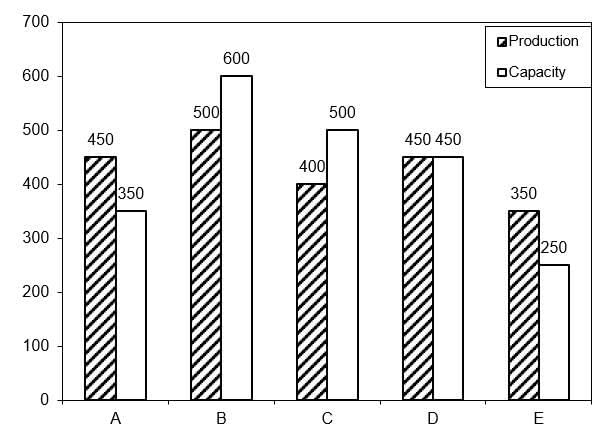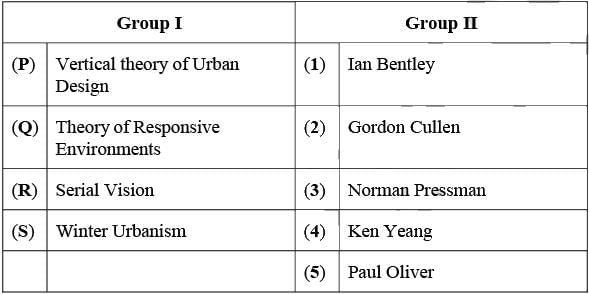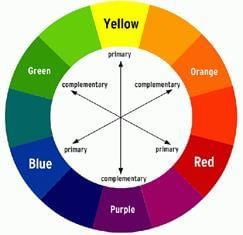GATE Architecture and Planning Mock Test - 2 (Planning) - GATE Architecture and Planning MCQ
30 Questions MCQ Test - GATE Architecture and Planning Mock Test - 2 (Planning)
The following inquiry comprises a main question followed by three statements. You need to analyze the question and the statements to determine which of the statements are not necessary to answer the question and can therefore be disregarded.
Q. Are any Lingoes dishonest?
(i) All Lingoes are Mingoes.
(ii) No Mingoe is dishonest.
(iii) Every Mingoe is a Lingo.
Q. Are any Lingoes dishonest?
(i) All Lingoes are Mingoes.
(ii) No Mingoe is dishonest.
(iii) Every Mingoe is a Lingo.
In a particular language, if "I can climb" is represented as "123", "you can climb" is represented as "125", and "he can swim" is represented as "267", then how is "he can swim" coded?
After hours of playing tennis, I feel too fatigued to walk back.
The average of the monthly salaries of M, N and S is ₹ 4000. The average of the monthly salaries of N, S and P is ₹ 5000. The monthly salary of P is ₹ 6000. What is the monthly salary of M as a percentage of the monthly salary of P?
The graph below illustrates the total production and capacity of five different companies. Using the information from the graph, respond to the following query:

Capacity utilization is defined as Production / Capacity x 100. What is the average capacity utilization for the five companies combined? _____
Statement: Not every company that hurried to acquire telecom licenses conducted a comprehensive and trustworthy due diligence, nor did they possess adequate financial support. Once the licenses were granted, a number of them failed to remit the license fee, and those that did experienced significant losses for an extended period.
Conclusions:
(i) The majority of telecom firms overestimated the financial sustainability of the business.
(ii) The government incurred substantial losses when the companies that received licenses defaulted.
If 20 carpenters can produce 40 chairs in 60 days, how many days will it take for ten carpenters to create 10 chairs?
People possess an inherent sense of compassion and honesty. In a study involving wallets that seemed to be “lost” and were positioned strategically, it was discovered that wallets containing money are more frequently returned than those that do not have any money. Likewise, wallets that included both money and a key were returned more often than those that had only the same amount of money. This indicates that the main cause of this behavior is rooted in compassion and empathy. Which of the following represents the CORRECT logical conclusion based on the details presented in the passage above?
A rhombus is created by connecting the midpoints of the sides of a unit square. What is the diameter of the largest circle that can be inscribed within this rhombus?
According to NBC 2016, automatic sprinklers must be installed in the basements of residential buildings when the area surpasses ____.
The command utilized to segment an object into parts with specified lengths is ____
The complementary color to Blue is _____
The area of brick walls is measured in square meters when the wall's thickness is
In a suspension bridge, the main cable supports the deck using hangars that are spaced evenly along the bridge's length, creating a uniformly distributed load. If we disregard the weight of the cable in comparison to the applied loads, what is the most accurate approximation of the shape that the cable assumes under this loading condition?
The term Golden Ratio signifies ___.
Which of the following locations were included in the Ramsar List in the year 2020?
According to the census data of India, what is the minimum population density required for an area to qualify as urban?
The proper order of the following stages in Construction Project Development, according to the National Building Code of India 2016, is ___.
- p. Resource Planning
- q. Project Inception
- r. Commissioning and Handing over
- s. Tendering
- t. Site Survey and Soil Investigation
- u. Selection of Construction Methodology
Align the items in Group I with the corresponding systems indicated in Group II.

Pair the Urban Design Concepts listed in Group I with their respective Proponents from Group II.

When using a wet and dry bulb psychrometer to assess relative humidity, what readings are considered?
According to the NBC, the maximum permissible travel distance, in meters, for an exit in a residential occupancy shall be ________. (Provide your answer as a whole number)
A solar energy facility is planned to be set up at a specific location. The installation cost and the yearly maintenance expenses are INR 6,00,000 and INR 18,000, respectively. It is anticipated to produce 500 kWh of electricity each month. Given that the unit price of electricity is INR 8, the payback period for the investment, in years, would be ____________ years.
Determine the stopping sight distance (in meters) when the speed v is 85 km/h and the coefficient of friction f is 0.10.
Associate the elements in Group-I with the corresponding phases of travel demand modeling in Group-II.

Which of the following assertions about the regional satellite navigation system, NavIC, are accurate?
Identify the institution(s) that are specified by the 73rd Constitutional Amendment Act, 1992 of India.
A traffic survey conducted over 24 hours at a specific road section recorded 1200 vehicles on a Thursday in July. Given that the daily adjustment factor for Thursday is 1.141 and the monthly adjustment factor for July is 0.913, what is the Annual Average Daily Traffic (in veh/day, rounded to the nearest integer)?
A structure covering an area of 4500m² was erected 5 years ago on a plot measuring 1 hectare. The current market price of vacant land in that area is 100/m², while the current construction cost for a similar building is Rs. 2700 per square meter. Assuming that the building's value is depreciating at a steady rate of 8% per year, what is the present value of the property calculated using the Value by Cost Method in lakhs?























